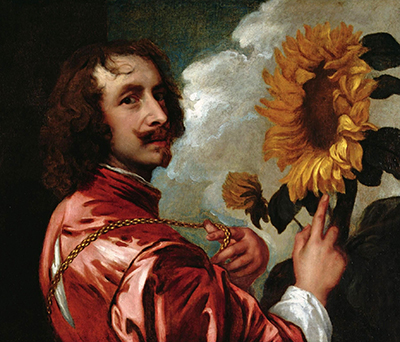The sunflower found in the painting makes this one of Anthony van Dyck's more memorable self portraits
There are several interesting aspects to this painting, particularly when placed in context with the rest of his ouevre. The artist chooses to look out at the viewer in this painting, almost as if surprised by their presence. Despite this, he still looks calm and contented as he appreciates nature.
There is also a gold chain worn by Van Dyck which was actually gifted to him by King Charles I, just a few years earlier. Its inclusion in this painting may have been for more than just aesthetic value, though the golden tones do work well on his pinkish jacket.
The light in this painting comes in from the bottom left and is particularly subtle. It brightens areas of the sunflower plus the artist's clothing and one side of his face. It is clearly not as dramatic as the way in which Rembrandt and Caravaggio would contrast different areas of their paintings.
The symbolism found in this painting attempts to place the artist as devoted to King Charles I just as the sunflower is to the sunshine that bursts across it. Their relationship appears to have grown organically with Van Dyck now at the peak of his powers (this painting was completed around 1632-1633).
Self-portraits have long since provided artists with an accessible means to perfecting their skills of portraiture whilst some have even found it an easy way to make and sell art quickly. Rembrandt famously produced endless self-portraits, having discovered just how popular they were in his local art market.




